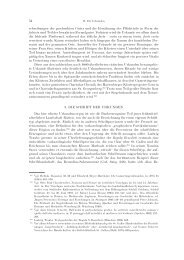Chapter Three ANTHOLOGIES AND ANTHOLOGISTS Between c ...
Chapter Three ANTHOLOGIES AND ANTHOLOGISTS Between c ...
Chapter Three ANTHOLOGIES AND ANTHOLOGISTS Between c ...
You also want an ePaper? Increase the reach of your titles
YUMPU automatically turns print PDFs into web optimized ePapers that Google loves.
90<br />
Part One: Texts and Contexts<br />
the presence of the word 4óqiton both in I, 30 and in I, 116. 3–4. Scribe A made<br />
up for his mistake by rewriting AP I, 116. 3–4 in its original form, while scribe<br />
J, taking over on the next page, wrote down the text of AP I, 30. The original<br />
sequence of epigrams in the exemplar they were copying must have been as<br />
follows: AP I, 115; I, 30; and I, 116. 3–4. This also explains the heading<br />
attached to AP I, 116: “on the same”, i.e., “on Christ” – the subject matter, not<br />
of AP I, 115, but of AP I, 30.<br />
The collection of Christian epigrams is not a later addition to the anthology<br />
of Cephalas, as most scholars seem to believe, but forms part of the original<br />
Cephalas. First of all, as Alan Cameron observed, at least four epigrams in AP I<br />
(nos. 33–36) derive from the Cycle of Agathias 22 . It seems very unlikely that<br />
Cephalas, while thumbing through his exemplar of the Cycle, would have<br />
skipped these beautiful epigrams only because they deal with archangels instead<br />
of pagan deities. In fact, the mere suggestion would question the ethics<br />
of the very person who was to become protopapas at the Byzantine court.<br />
Secondly, the collection of Christian epigrams was also to be found in two<br />
independent copies of Cephalas’ anthology: the Cephalan source used by the<br />
Souda for the numerous epigrams it quotes, and the apograph made by Michael<br />
Chartophylax and checked by the Corrector. The Souda quotes a few verses<br />
from epigrams in AP I 23 , and the Corrector makes no less than fifteen corrections<br />
in the text of the Palatine manuscript. Most of these corrections are<br />
insignificant and may have been the Corrector’s own conjectures, but the<br />
excellent emendations: l7ssan instead of l8qhn (AP I, 10. 72) and än5acon<br />
instead of än5scon (AP I, 92. 3), indicate that the Corrector had a better text in<br />
front of him 24 . Thus there were at least three tenth-century manuscripts combining<br />
the collection of Christian epigrams with the anthology of Cephalas: the<br />
Palatine manuscript itself, Michael Chartophylax’ apograph and the manuscript<br />
used by the redactors of the Souda. Thirdly, AP I contains a great<br />
number of verse inscriptions. As one would expect, most of these verse inscriptions<br />
were copied in Constantinople: AP I, 1–18, 96–98, 104, 106–107, 109–114<br />
and 120–121; but the epigraphical survey also included other Byzantine cities,<br />
such as Ephesus, Caesarea and Cyzicus: AP I, 50, 91, 92–93, 95 and 103. As<br />
Gregory of Kampsa is known to have visited these cities for his collection of<br />
verse inscriptions, it is very likely that he is the epigrapher who contributed to<br />
what was to become AP I.<br />
22 CAMERON 1993: 152–158. See also the interesting study by P. SPECK in: Varia II (Poik5la<br />
Byfantin1 6). Bonn 1987, 357–362. BALDWIN 1996: 101–102 is not entirely convinced by<br />
Cameron’s arguments.<br />
23 See CAMERON 1993: 151.<br />
24 For the 15 corrections, see STADTMÜLLER 1894–1906: ad locum, AP I, 10. 51; 10. 72; 19. 3;<br />
63. 2; 65. 1; 66. 1; 66. 2; 67. 1; 85. 1; 86. 2; 90. 1; 92. 3; 94. 6; 98. 4; and 116. 1.




